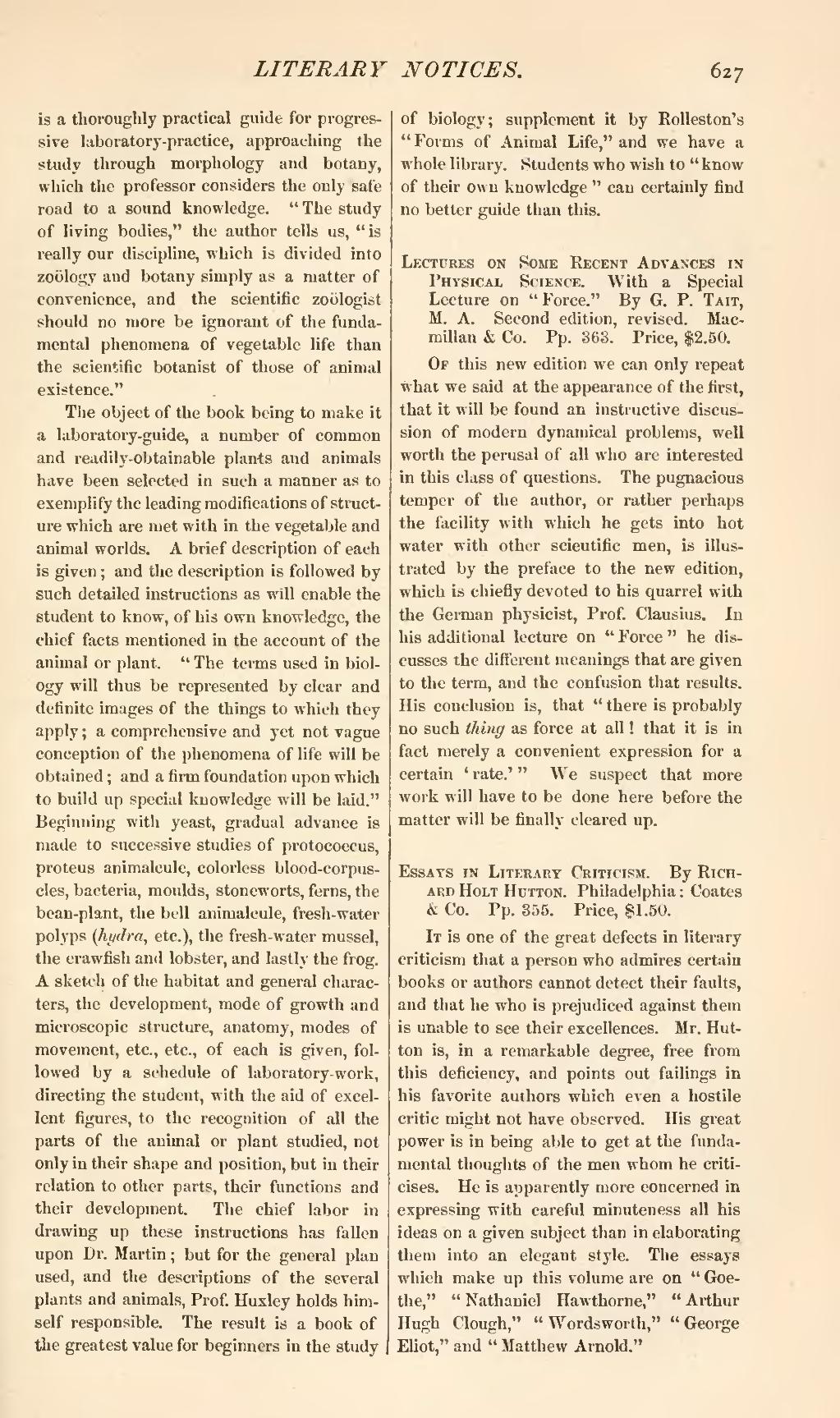is a thoroughly practical guide for progressive laboratory-practice, approaching the study through morphology and botany, which the professor considers the only safe road to a sound knowledge. "The study of living bodies," the author tells us, "is really our discipline, which is divided into zoology and botany simply as a matter of convenience, and the scientific zoölogist should no more be ignorant of the fundamental phenomena of vegetable life than the scientific botanist of those of animal existence."
The object of the book being to make it a laboratory-guide, a number of common and readily-obtainable plants and animals have been selected in such a manner as to exemplify the leading modifications of structure which are met with in the vegetable and animal worlds. A brief description of each is given; and the description is followed by such detailed instructions as will enable the student to know, of his own knowledge, the chief facts mentioned in the account of the animal or plant. "The terms used in biology will thus be represented by clear and definite images of the things to which they apply; a comprehensive and yet not vague conception of the phenomena of life will be obtained; and a firm foundation upon which to build up special knowledge will be laid." Beginning with yeast, gradual advance is made to successive studies of protococcus, proteus animalcule, colorless blood-corpuscles, bacteria, moulds, stoneworts, ferns, the bean-plant, the bell animalcule, fresh-water polyps (hydra, etc.), the fresh-water mussel, the crawfish and lobster, and lastly the frog. A sketch of the habitat and general characters, the development, mode of growth and microscopic structure, anatomy, modes of movement, etc., etc., of each is given, followed by a schedule of laboratory-work, directing the student, with the aid of excellent figures, to the recognition of all the parts of the animal or plant studied, not only in their shape and position, but in their relation to other parts, their functions and their development. The chief labor in drawing up these instructions has fallen upon Dr. Martin; but for the general plan used, and the descriptions of the several plants and animals, Prof. Huxley holds himself responsible. The result is a book of the greatest value for beginners in the study of biology; supplement it by Rolleston's "Forms of Animal Life," and we have a whole library. Students who wish to "know of their own knowledge" can certainly find no better guide than this.
Lectures on Some Recent Advances in Physical Science. With a Special Lecture on "Force." By G. P. Tait, M. A. Second edition, revised. Macmillan & Co. Pp. 363. Price, $2.50.
Of this new edition we can only repeat what we said at the appearance of the first, that it will be found an instructive discussion of modern dynamical problems, well worth the perusal of all who are interested in this class of questions. The pugnacious temper of the author, or rather perhaps the facility with which he gets into hot water with other scientific men, is illustrated by the preface to the new edition, which is chiefly devoted to his quarrel with the German physicist, Prof. Clausius. In his additional lecture on "Force" he discusses the different meanings that are given to the term, and the confusion that results. His conclusion is, that "there is probably no such thing as force at all! that it is in fact merely a convenient expression for a certain 'rate.'" We suspect that more work will have to be done here before the matter will be finally cleared up.
Essays in Literary Criticism. By Richard Holt Hutton. Philadelphia: Coates & Co. Pp. 355. Price, $1.50.
It is one of the great defects in literary criticism that a person who admires certain books or authors cannot detect their faults, and that he who is prejudiced against them is unable to see their excellences. Mr. Hutton is, in a remarkable degree, free from this deficiency, and points out failings in his favorite authors which even a hostile critic might not have observed. His great power is in being able to get at the fundamental thoughts of the men whom he criticises. He is apparently more concerned in expressing with careful minuteness all his ideas on a given subject than in elaborating them into an elegant style. The essays which make up this volume are on "Goethe," "Nathaniel Hawthorne," "Arthur Hugh Clough," "Wordsworth," "George Eliot," and "Matthew Arnold."

